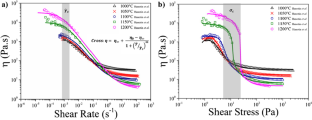Thixotropic behavior of a glass melt of nuclear interest containing platinum group metal particles
Abstract
Abstract
Platinum group metals (PGM) particles are generally found in nuclear borosilicate glasses resulting from the melting, at 1200 °C, of a glass precursor and fission products issued from spent fuel reprocessing. Contrary to some other elements, such as iron, nickel, and chromium, these particles are not incorporated chemically in molten glasses. During the melting step, the presence of these metals as suspended particles of a few microns has an impact on the rheological properties of the material, leading to a non-Newtonian behavior. Their impact on the process is the object of characterization and modeling of many studies that have established that the melt presents a shear-thinning and thixotropic behavior. In this work, a deeper analysis of the thixotropic behavior of a simulated nuclear glass melt containing 3.0 wt% (1.02 vol%) of PGM particles is presented. Steady and transient state rheological measurements were performed over a wide shear rate range using a stress-imposed rheometer at temperatures ranging from 1100 to 1250 °C. A mathematical modeling of the glass melt suspension thixotropic behavior is presented for the first time, using a thixotropic model akin to that proposed by Moore. This model is found to explain and predict successfully the rheological behavior of the material. In particular, it allows predicting the transient behavior of the samples from steady-state experiments, without additional adjustable parameters. The present study thus provides an important input for the modeling of the vitrification process.


 求助内容:
求助内容: 应助结果提醒方式:
应助结果提醒方式:


